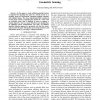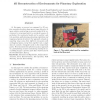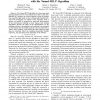50 search results - page 2 / 10 » Adaptable Path Planning in Regionalized Environments |
CDC
2009
IEEE
13 years 9 months ago
2009
IEEE
In this paper, a novel artificial potential function is proposed for planning the path of a robotic sensor in a partially observed environment containing multiple obstacles and mul...
CRV
2005
IEEE
13 years 11 months ago
2005
IEEE
In this paper we present our approach to 3D surface reconstruction from large sparse range data sets. In space robotics constructing an accurate model of the environment is very i...
AIPS
2009
13 years 6 months ago
2009
Recent research in robot exploration and mapping has focused on sampling environmental hotspot fields. This exploration task is formalized by Low, Dolan, and Khosla (2008) in a se...
ICRA
2010
IEEE
13 years 3 months ago
2010
IEEE
Abstract— Trajectory planning and optimization is a fundamental problem in articulated robotics. It is often viewed as a two phase problem of initial feasible path planning aroun...
CDC
2008
IEEE
13 years 11 months ago
2008
IEEE
— The Tunnel-MILP algorithm is a three stage path planning method for 2-D environments that relies on the identification of a sequence of convex polygons to form an obstacle fre...



